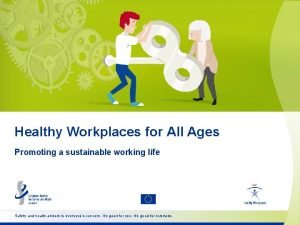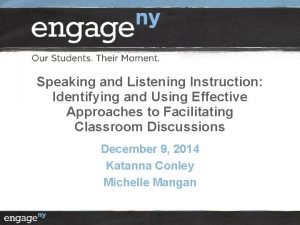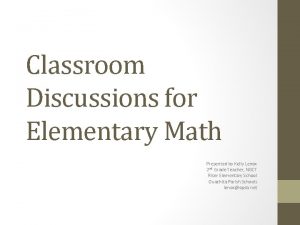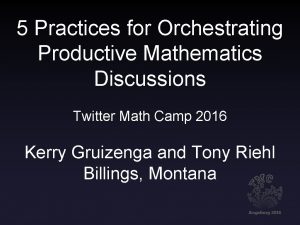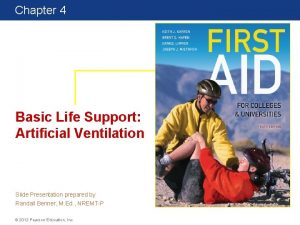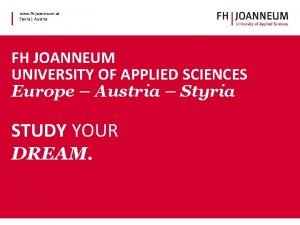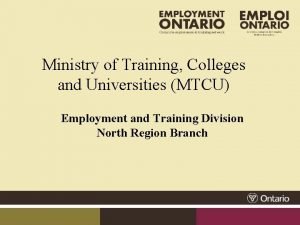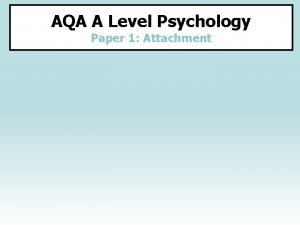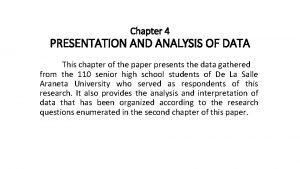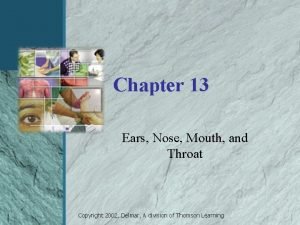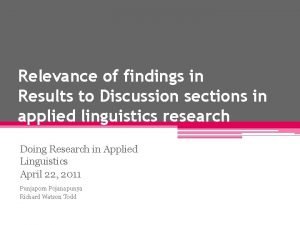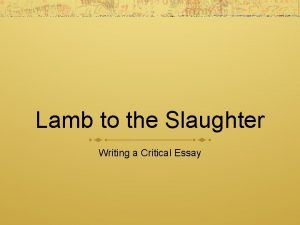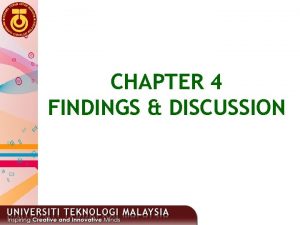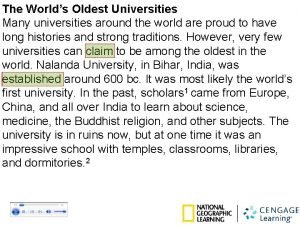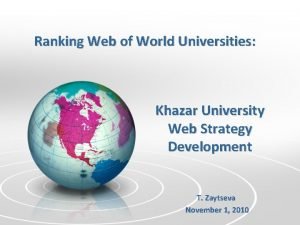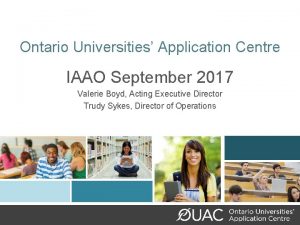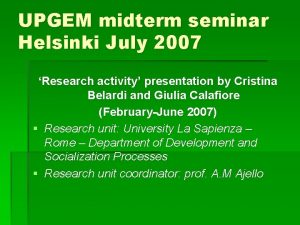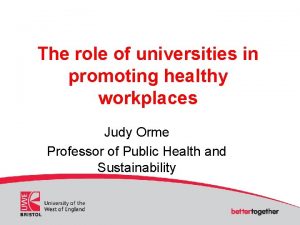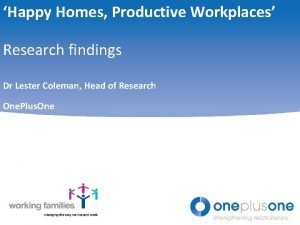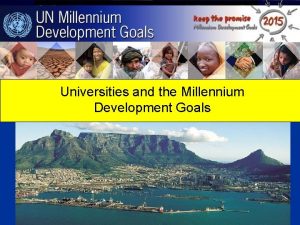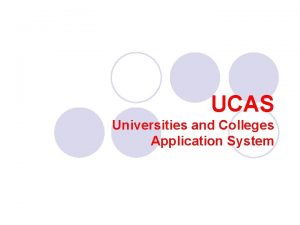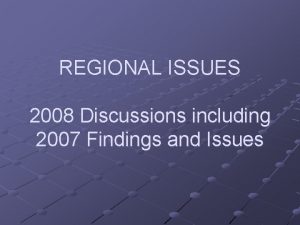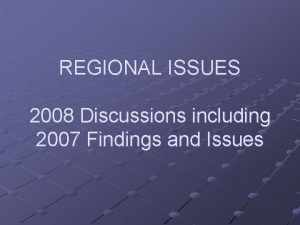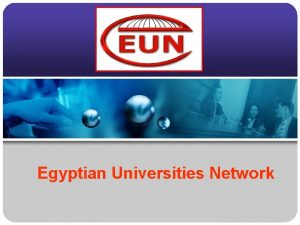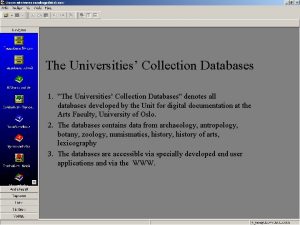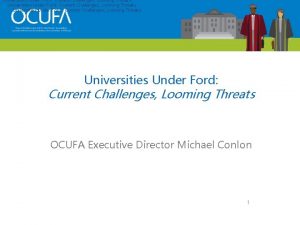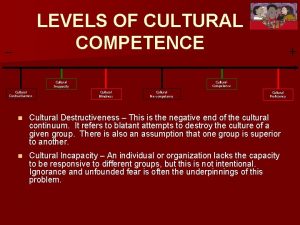Universities as cultural workplaces UPGEM findings and discussions


























- Slides: 26

Universities as cultural workplaces UPGEM findings and discussions Dr. Cathrine Hasse, Associate Professor, DPU, Aarhus University, Denmark WWW. UPGEM. DK

Innovation: Looking at universities as work-place cultures § A. Qualitative studies of the cultural working environment of academic staff at universities. § B. Identify local cultural-historical processes creating ‘leavers’ – especially female leavers

UPGEM Project-staff Finland Italy Estonia Finland Denmark University of Helsinki (CAW) Center for Activity Theory and Developmental Work Research Senior staff: Prof. Yrjö Engeström Dr. Merja Helle Research assistant: DPU- Aarhus University Senior staff: University of Tartu (UT) Dr. Cathrine Hasse La Sapienza (LS) Senior Staff Research assistants: Senior staff: Dr. Endla Lõhkivi, Stine Trentemøller Prof. Anna Maria Ajello Philosophy of Science Anne Bjerregaard Sinding Helsinki School Director of the Institute of Lone Svinth of Economics (HSE) Agata Heymowski Social Psychology Senior Staff: Research Assistant: Lena Dannow Dr. Kristina Rolin Research assistant: Katrin Velbaum Maja Hojer Department of Social and Giulia Calafiori Mari-Lis Tiina Moral Philosophy Christina Belardi Jenny Vainio Project co-ordination DPU – Aarhus University Project co-ordinator: Dr. Cathrine Hasse Project assistant: Stine Trentemøller Administrative staff at DPU: Annette Hjorth Knudsen Camilla Høgenhav, Niels-Henrik Meedom Poland University of Lódz (UL) Senior staff: Prof. Elzbieta H. Oleksy Director Of Women’s Studies Center (WSC) Research assistants: Patrycja Chudzicka Anna Diekmann Malgorzata Miazek Bartlomiej Zawardon

Physics as case: Stayers and Leavers § Stayer fields: Geophysics, theoretical physics, nano physics, solid state physics, particle physics, nuclear physics, X-ray physics, aerosol physics, astronomy, meteorology, material physics etc. § Positions held by leavers: Designers, Cleaners, Public Researcher, Industrial researcher, Patent Consultants, Academic administration, Website administrators, Well site engineers, College teachers, Record managers, Medical physics, Research & development in high technology companies, Energy industry, Specialist positions in public sector, HR management, Polytechnics and high school, Investment companies, Dissemination of Didactics, Retired, Unemployed

Data collection + seminars Data 1. 235 interviews with male and female physicists translated into English. Aprox. 50% of the informants are employed outside of academia in the partner country. 2. Field observations from 20 physics institutes 3. X-Ray of 20 physics institutes and other quantitative data 4. Information boxes with cultural historical background information. 5. Seminars: 6 weeks in Copenhagen 2006, 1 -2 weeks in Estonia, Finland, Poland Italy in 2006 -2008.

Target Countries where the Target Countries interviews are carried out interviews are where carriedthe out Other target Countries where statistical data are collected

IUPAP Conference: Woman in Physics Paris 2002 Figure Caption: Data collected for the conference and analysed by K Wiesner

UPGEM X-ray: Women in % § § § Associate professor DK 10 FI 12 EST 11 PL 14 IT 33 Professor 3 9 10 13 23

Discussions § More female students § Girls Schools § Former communist countries § Catholic/Protestant § Class society vs. ‘Gender’ society

Draw the Line Ways into physics as culture: § § § Family background Teachers’ influence Motivation and love for physics Ph. d. – offers and driftwood Mentorship

PUSH / PULL Factors at universities as work-places Push factors explicit and implicit – recurring themes § Low pay + Short term contracts § Insufficient organization of workplace § Hidden Competition § Stereotypical identities § Lack of acknowledgement § Political changes § Lack of career perspectives § Work motivational problems § Bad working environment (conflicts, harassment) § Mobility requirements Pull factors § Family responsibility § New job possibilities (i. e. in industry or business) § Better pay § Better career options

Draw the Line The particular problems for female researchers in these local cultures: § Discrimination against women § Downplay of femininity § Sexual harassment § Perceptions of womens careers as inseparable from family responsibility § Lack of female role-models and identification possibilities with stereotypes

Draw the Line The challenge of change: § The influence of political changes on the development of the discipline of physics § Change in managerial structures and administration § Change in access to communication and equipment § From generation to generation

Draw the Line Problems connected to university as workplace culture: § Open and hidden competition § Loneliness in Academia, Lack of feedback § Demands of mobility § Power structures § Reconcilliation of family and work-life § New masculinities Potential leavers in spite of passion for physics

MODEL OF CULTURE CONTRAST ANALYSIS

The analytical tools § Physics in culture embedded in local national cultures as it is presented in the national reports in ‘Draw the Line’ § Physics as culture presented as the three ideal types culture-contrast analysis presented in ‘Break the Pattern’. § (www. upgem. dk from November 2008)

Ideal-types in Physics Culture The individual physicist in the competitive physics context: Hercules. The caring physicists in social context: The Caretakers The diligent physicist in the work context: The Work-Bees

Ideal types in workplace cultures Hercules Focus: Caretakers Physics & the realm Physics for society & Physics as a job of physics science surrounding world Playful, curious, to physics: daring, ambitious Approach Social, curious, Diligent, serious, confident fortuitous Workplace Individualistic. Devotion. Culture: Worker bees Relational, respect Assessments. Sacrifices. & interdependency scapegoat personal. Competition: competition. 1 on 1, with all means Depends on the leadership. Professional rather than Group vs. group. Uninterested in

Ideal types in physics as culture Hercules Power structure: Worker bees Less transparent, Group hierarchy. more unstable. Individual stable. Power is for the power, reads power plays. Group or to meet. obligations in group. Leader. Work/family work Caretakers Physics before family. most stable. Uninterested in strategy and power plays. Distance to the powerful H. Dilemma; both are Disapprove of long Balance: Late work hours, Long equally important. hours, but stay late if stays abroad if fruitful Disapproves of long required. Enjoys spare time. work hours for show. Gender: Will use gender & harassment if it fits the culture of. the power play Little chance of gender Not likely to discriminate discrimination it will but will not react against a be retaliated by the. discriminating leader group, they react against it

Problems identified in UPGEM: Harassment Different kinds of harassment in relation to competition or lack of explicit rules for conduct: a. Hercules – Competitive harassment, 1: 1, Sexual harassment, individuals solve problems a. Caretakers – The young or weaker groupmembers are exploited. Group-leaders exploit and solve problems b. Worker-Bees – top-down leaders solve problems if they become aware

Problems identified in UPGEM: Competition Different kinds of competition for funding, positions etc. a. Hercules – hidden-open 1: 1 anything goes b. Caretakers – hidden-open, group against group, socially accepted means (e. g. nepotism) c. Worker-Bees – no competition on bottom, hidden-open on top

Conflicts in physics as culture – who do not fit in? Caretaker culture: 1. Those who are ‘betraying’ the group – who do not believe in group effort and challenge the group structure. 2. The loner Worker-bee culture: 1. Those who challenge the ‘boss’ 2. Those who show to many private feelings at work Hercules culture 1. Those who will not fight for priviledges 2. Those who openly show that they prioritize family, children hobbies etc.

Draw the Line and Break the Cultural Patterns § Drawing the line at the workplace § ‘Pockets’ of balanced ideal type workplaces § How to break cultural patterns? § All ‘types’ are equally needed!

Conclusion of the UPGEM project (so far…) § To break patterns we suggest that action is taken to break cultural pattern, which does not target women but the whole of the workplace environment. This we argue from our analysis will not only help women but also many men in pursuing careers in physics.

Titles of publications: § Draw the Line Proceedings § Break the Pattern

Homepage §http: // §www. upgem. dk
 Healthy workplaces for all ages
Healthy workplaces for all ages Healthy workplaces campaign
Healthy workplaces campaign Speaking and listening: effective group discussions
Speaking and listening: effective group discussions Classroom discussions in math
Classroom discussions in math 5 practices for orchestrating productive math discussions
5 practices for orchestrating productive math discussions Pearson
Pearson Fh
Fh Ufa state petroleum technical university
Ufa state petroleum technical university Chelyabinsk state university
Chelyabinsk state university Chon buri colleges and universities
Chon buri colleges and universities Yaroslavl state technical university
Yaroslavl state technical university Who's who in american colleges and universities
Who's who in american colleges and universities Mtcu sudbury hours
Mtcu sudbury hours Presenting insights and findings
Presenting insights and findings Psychology aqa a level spec
Psychology aqa a level spec Chapter 4 data analysis and findings
Chapter 4 data analysis and findings Mouth and throat assessment normal findings
Mouth and throat assessment normal findings Findings and discussion
Findings and discussion Lamb to the slaughter thesis statement
Lamb to the slaughter thesis statement Site:slidetodoc.com
Site:slidetodoc.com Chapter 4 findings and discussion
Chapter 4 findings and discussion Worlds oldest university
Worlds oldest university Sura regional
Sura regional Khazar
Khazar Universities that offer pharmacy in nigeria
Universities that offer pharmacy in nigeria Ged testing centers in pakistan
Ged testing centers in pakistan Ontario universities' application centre founded
Ontario universities' application centre founded
